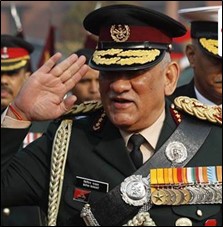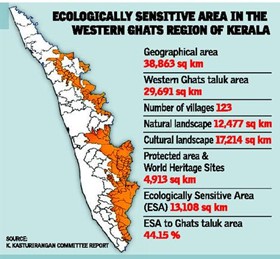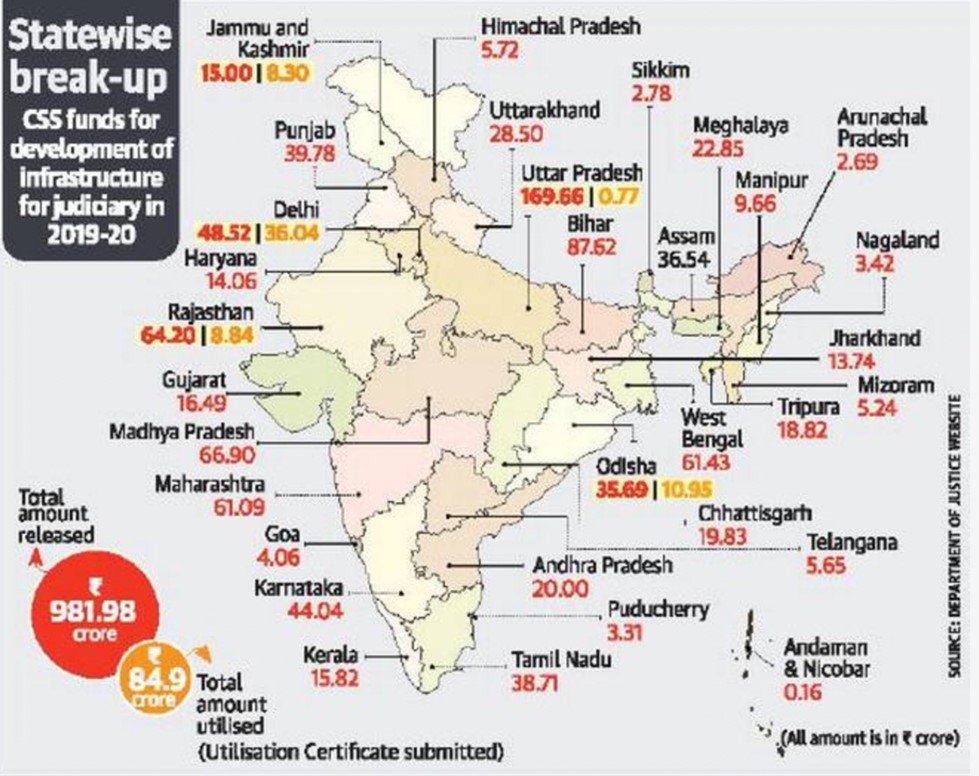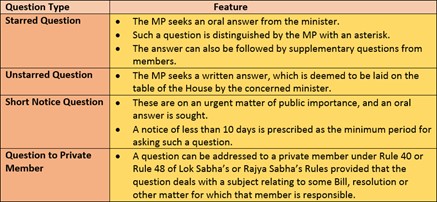Friday, 10th December 2021
SIPRI Report on Arms trade in 2020
In News
A new report by the Stockholm International Peace Research Institute (SIPRI) features three Indian companies in the top 100 for combined arms sales in 2020
About the News
- Share in Defence Manufacturing: According to a new Report by SIPRI, India has the smallest share - 1.2 %, among the top 11 defence manufacturing nations. USA topped with 54% of the combined arms sales of the top 100.
- Arms Sales: Combined arms sales by the three Indian companies in the Top 100 defence manufacturers worldwide grew by 1.7%. These were: Hindustan Aeronautics Limited (HAL), Indian Ordnance Factories and Bharat Electronics Limited (BEL).
- Ordnance Factory Board (OFB), which comprised the Indian Ordnance Factories, has been dissolved and seven new Public Sector Undertakings created in its place.
- Developments in India’s Defence Sector: In 2020 the Indian Government announced a phased ban on imports of certain types of military equipment to bolster self-reliance in arms production.
- Domestic procurement has helped to shield Indian companies against the negative economic consequences of the pandemic.
Other Observations made in the Report
- Arms industry in COVID Pandemic: Arms sales increased even as the global economy contracted by 3.1 per cent during the first year of the pandemic, sustained by government demand for military goods and services.
- China on the rise: Chinese firms accounted for 13 per cent of total Top 100 arms sales in 2020, behind US companies and ahead of companies from the United Kingdom, which made up the third largest share.
- China has benefited from the country’s military modernization programmes, deepened involvement in emerging technologies and focus on military–civil fusion to become self-reliant in weapons production.
- Russian arms trade declining: The combined arms sales of the nine Russian companies recorded a 5 per cent decline. This marks a continuation of the downward trend observed since 2017.
- Notable Israeli presence: The arms sales of the three Israeli companies listed in the Top 100 reached $10.4 billion, or 0 per cent of the total.

Sources:
Inland waterways
In News
Inland Waterways Authority of India (IWAI) has found 25 out of 111 national waterways fit for cargo or passenger movements.
About Inland Waterways in India
- Background: The Ministry of Ports, Shipping and Waterways has declared 111 waterways (5 existing and the 106 new) as National Waterways (NWs) under the National Waterways Act, 2016 in its attempt to promote inland water transport in the country.
- Developed by: The Inland Waterways Authority of India under the Ministry of Shipping is developing the National Waterways for commercial navigation, including with assistance from the World Bank.
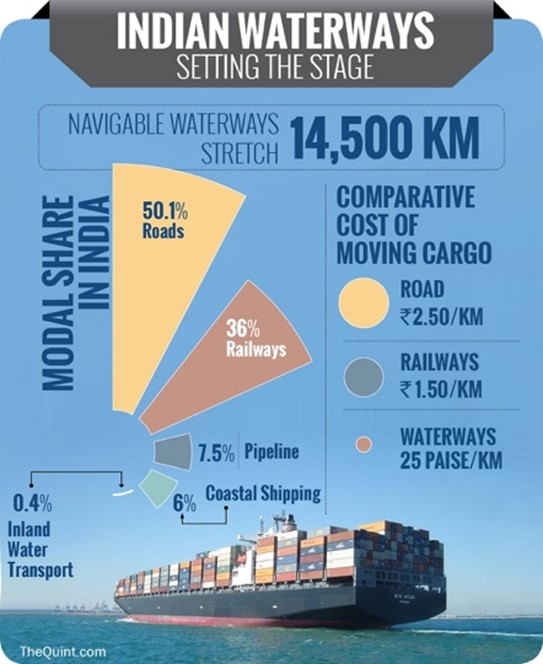
- Why Inland Waterways? This mode of transport has been recognised worldwide as environmentally friendly and economical, especially for cargo that do not depend on speed of delivery.
- India’s Waterways Capacity: Underutilised right now, India’s inland waterways carry about 55 million tonnes of cargo every year.
- The movement is currently restricted to Ganga-Bhagirathi-Hooghly, Brahmaputra, Barak, rivers in Goa, the backwaters in Kerala, inland waters in Mumbai and deltaic regions of Godavari-Krishna rivers.
- Efficiency of the Projects: The cargo movement on NWs has shown a 13% increase in 2020-21 compared 2019-20 due to the implementation of these projects both continuously and effectively.
Problems associated with Waterways
- To be a viable waterway, the river needs to have enough depth. This may lead to the problem dredging of river beds to maintain the adequate depth.
- Diversion of water for irrigation, industrial and other needs reduces the flow in the rivers resulting in the reduction of depth and shoal formation.
- Lack of adequate terminal facilities at the loading and unloading points being non-existent and where existent being inadequate.
- Inadequate vertical and horizontal clearances for plying vessels of economic size in many traditional waterway routes.
- Non availability of adequate navigational aids resulting in unsafe passage and high travel time.

Digital solutions for Ease of Doing Business
- Cargo Data Portal: The CAR-D (Cargo Data) Portal is a web-based portal for collection and compilation, analysis and dissemination of all cargo and cruise movement data of NWs to the stakeholders.
- PANI Portal: PANI or the Portal for Asset and Navigation Information is an integrated solution that compiles river navigation and infrastructure information on a single platform.
Source:
Geological Sequestration of CO2
In News
As per a recent research, the geological formations under India have potential to store at least 395 giga-tonnes (Gt) of carbon dioxide.
Details of the Research
- Potential of Carbon Sequestration in India: The geological formations under India have potential to store anywhere between 395 Gt to 614 Gt of carbon dioxide in the 26 sedimentary basins of India.
- Diverse Sources in India: India has diverse rock formations where carbon dioxide can be stored permanently in saline aquifers (porous rocks holding saltwater), depleted oil and gas fields, in coal seams and basalt rocks.
- Each of these has a different mechanism of holding the carbon dioxide, such as adsorption, compression and mineralization.
What is Geologic carbon sequestration?
- Geologic carbon sequestration is the process of storing carbon dioxide (CO2) in underground geologic formations. Geological formations considered suitable for CO2 storage
- Mature oil and natural gas reservoirs
- Oil- and gas-rich organic shale
- Uneconomic coalbeds
- Deep aquifers saturated with brackish water or brine (saline)
- Salt cavern
- Basalt formations
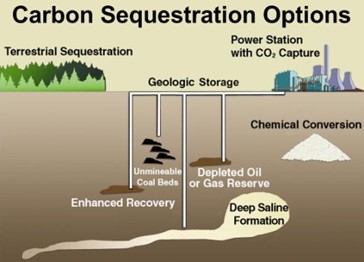
- The CO2 is usually pressurized until it becomes a liquid, and then it is injected into porous rock formations in geologic basins.
- This method of carbon storage is also sometimes a part of enhanced oil recovery, otherwise known as tertiary recovery, because it is typically used later in the life of a producing oil well.
- In enhanced oil recovery, the liquid CO2 is injected into the oil-bearing formation in order to reduce the viscosity of the oil and allow it to flow more easily to the oil well.
Need for Carbon Sequestration
- Present CO2 Emissions in India: India is estimated to emit around 2.7Gt of carbon dioxide every year. (One giga-tonne is one billion tonnes)
- Limiting Global Warming: It has acquired utmost importance in the international goal of limiting the rise of global warming to 1.5 degrees.
- Supporting Net Zero Mission 2070: India will need a Mission Carbon Capture to achieve India’s ambitious net zero goals.
Methods of Carbon Sequestration for India:
A successful Mission Carbon Capture for India will need to incorporate two broad approaches: nature-based and technology based.
- Nature-based solutions:
- Reforestation, afforestation, agroforestry, and improved land management practices.
- Geological and mineral
- Coastal blue carbon ecosystems (including salt marshes, mangroves, and seagrasses) and enabling large-scale sea weed cultivation
- Technology-based solutions:
- Carbon Capture, Utilization, and Storage (CCUS)
- Direct Air Carbon Capture and Storage (DACCS)
Source:
International Human Rights Day
On December 10, 1948, the United Nations General Assembly adopted the Universal Declaration of Human Rights (UDHR). International Human Rights Day commemorates this adoption. The UDHR is a milestone document, which proclaims the inalienable rights that everyone is entitled to as a human being - regardless of race, colour, religion, sex, language, political or other opinion, national or social origin, property, birth or other status. Available in more than 500 languages, it is the most translated document in the world. This year’s Human Rights Day theme relates to 'Equality' and Article 1 of the UDHR – “All human beings are born free and equal in dignity and rights.” The principles of equality and non-discrimination are at the heart of human rights. Human Rights Day is important, especially after covid-19, which has deepened poverty, raised inequality, discrimination and other gaps in human rights protection.

Sources:
Modernization of Indian Armed Forces
In News
In November 2021, Defence Ministry approved the proposals worth Rs 7,965 cr for Armed Forces modernization.
Introduction
- The developments in India’s immediate neighbourhood over the past decade created a widely sensed need for the rapid modernisation of the Indian armed forces.
- This is being reflected in some of the key initiatives such as Make in India, Defence Procurement Policy etc., so as to address to the complex security challenges that emanate from its hostile neighbourhood.
- However, the pace of modernisation of the Indian armed forces has been rather slow, and technologically, they are not where they should have been. Indigenous development of modern defence hardware continues to remain a concern and Indian policy aspiration for defence self-sufficiency remains largely elusive.
Need for defence modernization
- Possibility of Two front wars with China and Pakistan on the eastern, western and northern frontiers demand huge resource mobilisation at the same time on both the fronts.
- To maintain strategic autonomy: In the current geopolitical situation, it has become vital for India to maintain its regional autonomy. India needs to assert its presence and sovereignty over the border regions and for that, it needs to have modernised defence products and strategic autonomy over such defence products. This is currently being seen in case of S400 deal.
- Reduce imports: India consistently ranks among the top 5 arms importers. India must enhance indigenous defence capabilities as external dependence for weapons creates vulnerabilities in times of crisis.
- Changing nature of conflicts: Now the conventional war is unlikely. In the changing circumstances variety of threat like territorial, environmental, natural disaster, migration, drug trafficking, radicalization, terrorism, piracy and also threat to cyber, nuclear and energy security decides the requirement of the military organization.
- Global Aspirations: India aspires to be a responsible regional and global power. But this ambition is hampered due to lack of capability to support other nations. India should modernize its forces to act as a net security provider in Indo-Pacific, be the first point of contact in disaster management and humanitarian assistance etc.
Challenges in Defence Modernisation
- Rising manpower cost: Rising manpower cost and changing nature of modern warfare need prioritization and restructuring of the armed forces. The defence budget of Indian armed forces has increased by the factor of 2 from 2009-10 to 2018-19, but the pension budget for the same period of time has increased by a factor of 15.
- Budget deficit: With revenue expenditure invariably forming a large part of the armed forces budget, there is little left for capital expenditure, thus putting severe constraints on its modernisation ability.
- Lack of indigenous defence manufacturing: This situation is further exacerbated because of excessive dependence on costly imports, since in-house manufacturing ability of military hardware is almost negligible. Despite government’s push towards ‘Make in India’ the modernisation programme would have to depend on imports as it would take 10-15 years to show effective results.
- Absence of a clearly defined national security strategy: This creates confusion in prioritising our threats and finding solutions for them. Thus, while all round development of the military must take place, we need to decide whether we should give priority to threats along our land based borders or to domination of the Indian Ocean Region and any threats along our oceanic boundaries. This is important because limitation of resources dictates expenditure based on threat perception.
- Moreover, modernization of armed forces is the time-consuming process and requires a clear vision, strategy and national goal. It is the timely analysis of threat and building strategies to avert them.
- Poor Civil-Military Coordination: This creates delays and bureaucratic hurdles in the procurement process. This leads to inefficiency in expenditures, charges of corruption and mismatch of requirement and technological lags at the time of delivery of products.
- Non-integration of service headquarters: Before the creation of Chief of Defence Staff and Department of Military Affairs, the lack of “jointness”, integrated planning and synergy between the three armed forces, has been a distinctive feature of the Indian military.
Steps taken
- Funding Provisions:
- In September 2019, the government finalizes to spend $130 billion in 5 to 7 years to modernize the armed forces. The plan includes the acquisition of a range of weapon includes warship, missile, drone, fighter jet, surveillance equipment, rifle and creating architecture for artificial intelligence.
- A separate fund has been earmarked for supporting the start-ups (iDEX) and MSMEs for the development of design and new technology in the defence and aerospace sector.
- The government agreed to the 15th Finance Commission recommendation to constitute a Modernisation Fund for Defence and Internal Security (MFDIS), a non-lapsable dedicated fund to bridge the gap between projected budgetary requirements and allocation for internal security and defence. The indicative size of the MFDIS for 2021-26 is about ₹2.4 lakh crore.
- Boosting Indigenous Defence capability: Defence Acquisition Procedure, 2020, Restructuring of approximately 200-year-old Ordnance Factory Board into seven State-owned corporate entities; permitted Foreign Direct Investment of up to 74% in defence production through the Automatic Route, Defence Industrial corridors being setup in Uttar Pradesh and Tamil Nadu etc.

- For improving military organization:
- Chief of Defence Staff (CDS) created to provide “effective leadership at the top level” to the three wings of the armed forces.
- Creation of new Department of Military Affairs for better management of military resources and procurement.
- Theatre commands (TC) with tri-service capabilities: The existing 17 single-Service commands will be integrated into four geographical commands, each with elements from all three Services; with the Western TC responsible for Pakistan, the Northern TC for China, a navy-heavy Maritime TC for the Indian Ocean region, and the existing tri-service Andaman & Nicobar Command (ANC) projecting power into the eastern Indian Ocean and beyond; in addition would be an Air Defence/Space Command.
Conclusion: Modernization is the expression of the growth of national ambition. Modernization of armed forces is a complex process; it involves all the possible changes in the material capacity to meet the strategic objective. The process of military modernization entails: Modernization of manpower; Modernization of weapon systems; Modernization in defense infrastructure; Modernization in training; Modernization in professional orientation.
Question: The developments in India’s immediate neighbourhood and changing geopolitics over the past decade created a widely sensed need for the rapid modernisation of the Indian armed forces. Justify this statement with suitable examples.
Sources:
- Defence Ministry approves acquisition of arms, military equipment worth Rs 7,965 crore
- Modernisation of Defence Forces
- India’s Defence Modernisation: Challenges and Prospects
- FIRM ON MODERNISATION: INDIA'S DEFENCE BUDGET 2021-22
- Modernisation of Indian Armed Forces through Indigenisation
- India’s command structure of theatre commands
- India’s armed services must prepare for reform
- India’s weapon imports fell by 33% in last five years but remains world’s second-largest arms importer
- DEFENCE REFORMS
- Challenges in implementation of Modernisation of Armed Forces
- Modernization of Indian Armed Forces
- MODERNISATION OF THE INDIAN ARMED FORCES
- India’s Military Modernization: Challenges and Prospects
- Modernisation of Indian Army: Future Challenges
- Towards the future: India's defence modernisation in perspective
- CDS Bipin Rawat was scripting roadmap for reforms and upgrade, his boots hard to fill
- India Military Accelerates Historic Overhaul to Counter China
- Making the armed forces future ready: Challenges and opportunities
- Non-lapsable fund for India’s defence modernization
- Raksha Mantri Shri Rajnath Singh releases E-booklet on 20 MoD reforms in 2020
- Armed Forces continue to grapple with shortage of officers
C. Rajagopalachari
This is image of freedom fighter and statesman C. Rajagopalachari. One of the most influential leaders of India, C. Rajagopalachari, was born on December 10 in 1878. In 1916, he formed the Tamil Scientific Terms Society, an organisation that translated scientific terms of chemistry, physics, mathematics, astronomy and biology into simple Tamil words. When Mahatma Gandhi led the Dandi March in 1930, Rajagopalachari did the same at Vedaranyam, near Nagapattinam in the then Madras Presidency and broke the salt law. He also became the Editor of Mahamta Gandhi's newspaper, Young India. After Independence, Rajagopalachari was chosen to be the last Governor-General of India, in the absence of Lord Mountbatten. His tenure lasted from June 21 in 1948 to January 26 in 1950. He had sworn in as the Chief Minister of Madras on April 10 in 1952. His policy of introducing Hindi as a compulsory language in schools was highly protested by the people of Madras. He wrote a Tamil translation of the Ramayan, which was later published as Chakravarthi Thirumagan.
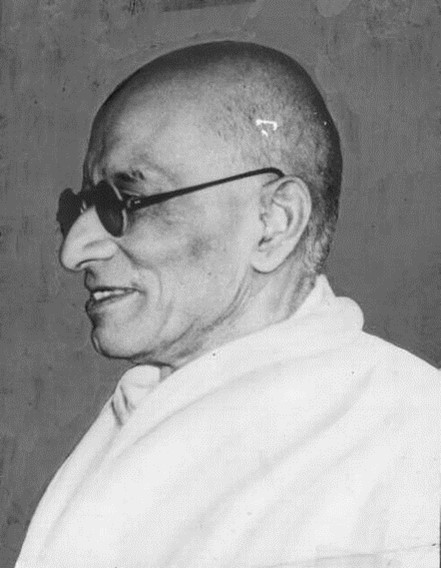
Sources:
Konyak tribe
- Context: Recently, 8 Konyak civilians were killed at the centre of violence in in Oting village of Mon district in Nagaland.
- The Konyak is the largest tribe inhabiting Nagaland followed by Ao, Tangkhul, Sema, and Angami. Other Naga tribes include Lotha, Sangtam, Phom, Chakhesang (Chokri), Rengma etc.
- They are known in Arunachal Pradesh as the Wanchos.
- They are known to be one of the fiercest warrior tribes in Nagaland as they were famous for their practice of head hunting. The decapitated heads were brought back as trophies and hung in a community barn known as a “baan”.
- A unique feature of the Konyak tradition is the practice of the Angh (king) system.
- Their three most significant festivals were Aolingmonyu, Aonyimo and Laoun-ongmo.

Source:
- Tattooed Headhunters, Warriors, Craftsmen: A History of Nagaland’s Konyak Tribe
- Explained: Konyak tribe numbers make them crucial to peace talks
Image Source:
Genome sequencing and Omicron variant
- Context: With the WHO categorising the newly discovered Omicron strain as a “variant of concern", medical experts have explained how it is detected in genome sequencing.
- Different variants simply mean that there have been mutations in one or more of the genes.
- In Omicron nearly about 50 mutations have occurred, out of which nearly 30 are in the spike protein that makes it different from the other variants.
- If there is a patient who is suspected with Omicron, the diagnosis relies on testing for the mutations that are called gene sequencing.
- The mutations in Omicron have occurred in the S gene. One of the S gene targets is not detected due to mutations and this is termed as the S gene dropout or S gene target failure which is a marker to identify the Omicron variant.
- The common RT-PCR kits used will be able to identify positive or negative, but will not be able to identify if the positive result is due to the mutation in the S gene.
- In this case genome sequencing helps in the identification of S gene dropout and confirms the Omicron infection.
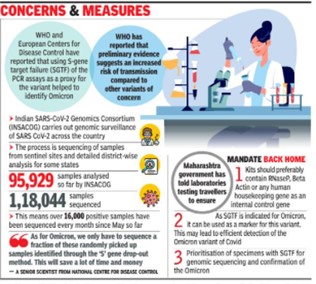
Source:
- How genome sequencing can confirm presence of Omicron variant, expert explains
- Explained | Can the Omicron variant of SARS-CoV-2 be identified quickly?
Image Source:
Tracker to study Omicron
- Context: The WHO has recently launched the Omicron variant assays and animal models study tracker.
- The tracker compiles information that will facilitate matching those who have materials for Omicron-related studies with those who need them.
- This initiative comes in the backdrop of the urgent need to evaluate the cross-reactivity, transmissibility, and pathogenicity of the Omicron
- The WHO has already been conducting research studies on variants of the SARS-CoV2 virus as the global understanding of the natural history of covid-19, clinical features, prognostic factors, and outcomes remain incomplete.

Source:
Invasive Snail Species: Kerala
- Context: A tiny snail found in the Edappally canal in Kochi has been flagged as an invasive species recently in Kerala.
- Physella acuta, globally branded as highly invasive species is a tiny snail with a striking, pellucid golden-yellow shell.
- It is considered native to North America but is now found in all continents except Antarctica. The snail was first reported in India in the early 1990s and is believed to have reached Kerala through the aquarium trade.
- Its rapid growth rate, air-breathing capability, and tolerance to pollution makes the species a potential competitor to native fauna.
- They play host to worms that can cause food-borne diseases and skin itches in humans.
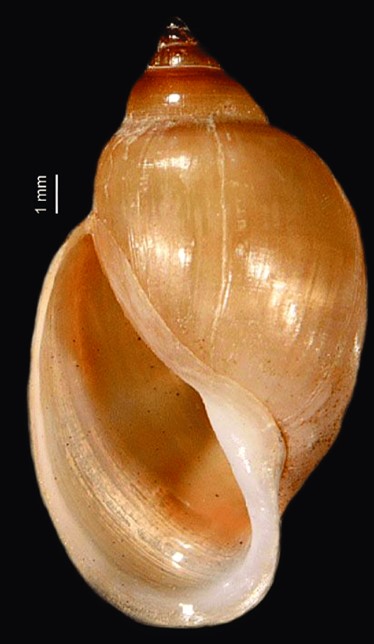
Source:
Image Source:
India and the elderly: Assessing the impact of COVID-19 and thinking forward: ORF
Essence: With the discovery of more transmissible variants like Delta and Omicron, there is a necessity of protecting our exposed older population. The 1st wave of COVID 19 asserted a higher risk amongst the elderly population. With lesser financial aid allotted for elderlies and their limited fluency with digital tools they become more vulnerable in the COVID times.
Among the elderlies, women especially are less economically independent and the lockdown also affected their livelihood more than men. Nutrition deficiency, gendered based violence, access to digital tools and vulnerability to more poverty are some of the parameters which make older women more vulnerable to adverse effect of COVID 19. Vaccine hesitancy is a far-reaching concern in India especially among elderly population (more in older men). The government of India took the cognizance of it but there are many other barriers which need to be removed. It is high time that the target of COVID 19 vaccination should focus on the senior citizens. It would be a human right violation if the senior citizens are discriminated from the younger generation.
Why to read this article?
- To understand that with the new variants of COVID surfacing, why India should take in account its elderly population and undertake suitable policy changes to ensure their survival.
- To realize that how older women are more vulnerable to adverse outcomes from COVID-19.
- The impact of COVID 19 on various vulnerable sections (GS II) is an essential aspect to be looked into from the perspective of examination.
Source:
The potential of Young India in driving growth and effecting social change: HT
Essence: The article highlights the dire need to invest in young people as it provides a crucial opportunity to transform the future of India. As the most significant part of brain development takes place in early ages and with India having the high number of young children, it should focus on these young minds realize their full potential.
Investing in young people has its own benefits like increase in lifetime earnings, life expectancy, and wellbeing and also poverty eradication. The goal is to enable young Indian girls and boys — wherever they may be — to realise their full potential.
Why you should read this article?
- To understand the potential that lies in Young India.
- To understand that why there is a dire need to empower young people.
Source:
Domestic Violence
Background
- Interfering in other’s domestic matters is not seen as a socially acceptable behavior.
- With rising cases of domestic violence, especially during Covid-19 lockdowns, such interventions/ interference became a necessity.
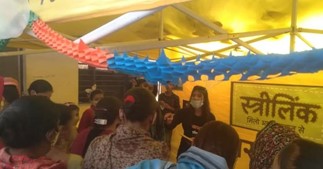
How intervening is leading to safety for women?
- Breakthrough, an NGO in Delhi launched a campaign ‘Dakhal Do’ for promoting bystander intervention in stopping acts of violence against women and girls in India's private and public spaces.
- It has been initiated to inspire the youngsters between the age-group of 18 and 25 years to call out acts of violence in their own lives or in spaces they move in.
- Over the years, Breakthrough has been able to bring about lasting positive changes in their intervention areas — increasing the probability of girls being enrolled in schools, increasing the age of marriage in Uttar Pradesh, encouraging the reporting of cases of violence, transforming gender-regressive views of adolescents, and more.
Quote:
“When it comes to abuse, you believe there’s no way out. There is always help. There is always a way out.” ― Rev. Donna Mulvey
Source:
Share the article
Get Latest Updates on Offers, Event dates, and free Mentorship sessions.

Get in touch with our Expert Academic Counsellors 👋
FAQs
UPSC Daily Current Affairs focuses on learning current events on a daily basis. An aspirant needs to study regular and updated information about current events, news, and relevant topics that are important for UPSC aspirants. It covers national and international affairs, government policies, socio-economic issues, science and technology advancements, and more.
UPSC Daily Current Affairs provides aspirants with a concise and comprehensive overview of the latest happenings and developments across various fields. It helps aspirants stay updated with current affairs and provides them with valuable insights and analysis, which are essential for answering questions in the UPSC examinations. It enhances their knowledge, analytical skills, and ability to connect current affairs with the UPSC syllabus.
UPSC Daily Current Affairs covers a wide range of topics, including politics, economics, science and technology, environment, social issues, governance, international relations, and more. It offers news summaries, in-depth analyses, editorials, opinion pieces, and relevant study materials. It also provides practice questions and quizzes to help aspirants test their understanding of current affairs.
Edukemy's UPSC Daily Current Affairs can be accessed through:
- UPSC Daily Current Affairs can be accessed through Current Affairs tab at the top of the Main Page of Edukemy.
- Edukemy Mobile app: The Daily Current Affairs can also be access through Edukemy Mobile App.
- Social media: Follow Edukemy’s official social media accounts or pages that provide UPSC Daily Current Affairs updates, including Facebook, Twitter, or Telegram channels.

